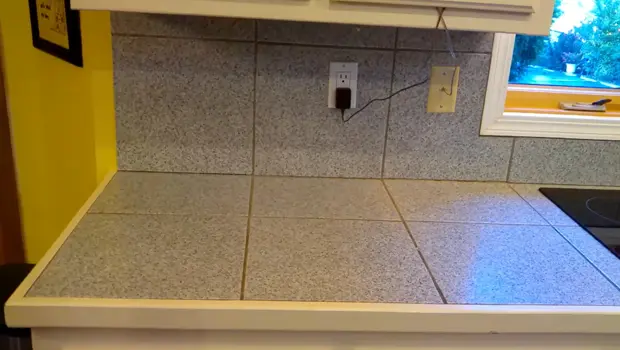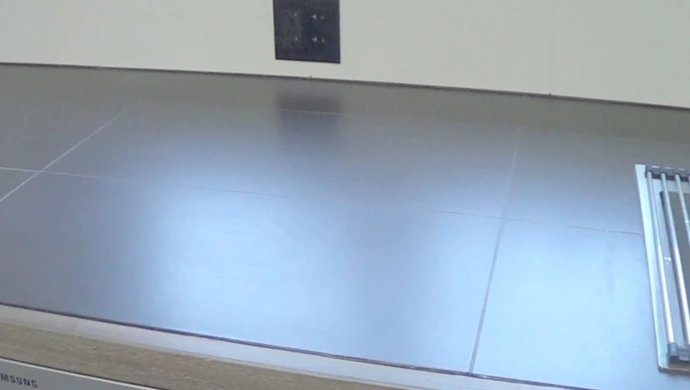Last Updated on October 30, 2022
Removing old countertops while renovating a kitchen is not always possible or desirable. Many homeowners don’t have the budget for new countertops, and some have tile countertops that are in acceptable condition but out of style. If you find yourself in either of these situations, don’t worry you can give your tile countertops a fresh look by covering them with thin quartz.
Quartz is a natural stone that is scratch, heat, and stain resistant, making it an ideal material for countertop applications. The fact is that most people are unaware of how to cover tile countertops with thin quartz.
We’re here to help. This guide will teach you everything you need to know about covering thin quartz over tile countertops. We’ll also provide some tips on choosing the right quartz for your project.
How to Cover Tile Countertops with Thin Quartz : Easy Guide

Quartz is a beautiful, durable material that provides a high-end appearance for tile countertops. Quartz is strong and durable, yet it is also very flexible. So, it can be easily applied over existing tile countertops without the need to remove the old tiles first. Plus, Quartz is non-porous, so it resists stains and is easy to keep clean.
Here is a step-by-step guide on installing thin quartz countertops in a professional manner:
Step One: Prepare the Tile Countertop Surface
Before you begin, it’s essential to prepare the surface of your tile countertop properly. Start by cleaning the area with soap and water, then use a tile cleaner or stripper to remove any wax or sealant from the surface. Once the surface is clean and dry, apply a layer of primer specifically designed for use on ceramic tile. This will help ensure that the quartz adheres properly to the surface.
Step Two: Measure and Cut the Quartz
After you have gathered all the necessary materials, the next step is to measure and cut the quartz. First, use a measuring tape to measure the length and width of your countertop. Next, use a straight edge to mark where you need to cut the quartz. If uncomfortable cutting the quartz, you can always ask a friend or family member for help. Once you have marked the Quartz, use a sharp knife to cut along the line. Be sure to wear gloves and safety glasses when doing this. After you have cut the quartz, it is time to move on to the next step.
Step Three: Apply Adhesive to the Back of the Quartz Pieces
Now it’s time to attach an adhesive to the back of each piece of quartz. You can use construction adhesive or epoxy for this step. If you’re using construction adhesive, apply it directly behind each quartz piece using a caulking gun. If you’re using epoxy, mix it according to the manufacturer’s instructions, then apply it backward using a putty knife. Be sure to work quickly so that the adhesive doesn’t have time to set before you have a chance to adhere the quartz to the countertop surface.
Step Four: Adhere the Quartz to the Tile Countertop
Now that the adhesive is set, you can begin to apply the thin quartz sheets to the countertop. It’s important to work quickly at this stage, as the adhesive will begin to set fast. Starting at one end of the countertop, peel back a corner of the backing on the quartz sheet and press it into place. Use a putty knife or other flat object to smooth out any air bubbles, then continue peeling and pressing until the entire countertop is covered. Once all of the pieces are in place, run your fingers along all of the seams to make sure they are well sealed. Then let the countertop dry for 24 hours.
Step Five: Caulk the Seams (Optional)
Once the countertop is dry, you may want to caulk the seams to give it a professional finish. You will caulk the seams at the intersection of the quartz countertop and the tile. This is an important step, as it helps to prevent water damage and mold growth. Clean the area around the seam with a damp cloth. Then, using a caulking gun, apply a bead of silicone caulk to the seam. Next, smooth the caulk with your finger or a putty knife. Allow the caulk to dry for 24 hours before using the countertop.
Following these steps will help you create a durable and long-lasting seal between the quartz and the tile. This will also create a smooth and polished look that will elevate the overall appearance of your kitchen.
What are the benefits of covering tile countertops with thin quartz?

You may be wondering what the benefits are of using thin quartz for covering tile countertops. Well, there are actually quite a few benefits to this type of countertop. If you don’t have any idea about the advantages, here are some key benefits:
Benefit 1: Easy Maintenance
Quartz is a Non-Porous Material, Which Means There is No Need to Seal It. Quartz is also a very strong material that is scratch and stain resistant. With proper care, your quartz countertop will stay looking shiny and new for years. If it does happen to get scratched or stained, the damage can usually be repaired quite easily. This makes quartz a low maintenance option for those who don’t want to spend a lot of time caring for their countertops.
Benefit 2: Aesthetically Pleasing
Not only are quartz countertops more durable than tile, but they are also more aesthetically pleasing. Quartz comes in a wide variety of colors and patterns, so you can find an option that perfectly complements your kitchen’s style. Plus, quartz countertops have a smooth, glossy surface that is easy to clean and maintain. In contrast, tile countertops can be porous and difficult to clean, and they often require sealing and resealing to prevent staining. With quartz, you can enjoy the beauty of tile without the hassle of upkeep.
Benefit 3: Durable and Long-Lasting
Quartz is one of the hardest minerals on Earth, which makes it an ideal material for countertops. It is heat resistant and will not scratch, chip, or stain easily. In fact, quartz is so tough that it is actually the second most abundant mineral in sandstone, a rock known for its durability. Because it is so strong, quartz countertops are a great choice for high-traffic areas like kitchens and bathrooms. They are also low maintenance and easy to clean, which makes them ideal for busy families. Quartz countertops are an investment that will last a lifetime.
Benefit 4: Easy to Install

Installing a quartz countertop is a project that most DIYers can handle. That’s because it comes in the form of a large, thin sheet that’s easy to cut and manipulate to fit your space. You won’t need any special tools or skills to install it, and you can even do it yourself in a weekend. Plus, since it’s so thin, quartz is also much lighter than other countertop materials like granite, making it easier to work with and less likely to cause damage to your cabinets during installation.
Benefit 5: Affordable
One of the most important benefits is that it is much more affordable than other options. For example, granite countertops can cost hundreds or even thousands of dollars, while quartz countertops are only a fraction of that price. Then quartz is also less likely to crack or chip than other materials, making it a more durable option in the long run. Thus, covering your tile countertops with thin quartz is a smart investment that will save you money in the long run.
These are just a few of the advantages of using thin quartz to cover tile countertops. As you can see, there are many reasons to choose this option for your kitchen or bathroom. If you’re looking for an easy to install, low maintenance, and affordable countertop option, thin quartz is the way to go.
FAQ’s
Let’s look at some of the frequently asked questions we receive when coating thin quartz on tile countertops, which will give you a better understanding of the process.
What are the different types of quartz?
How do I clean quartz countertops?
Are quartz countertops heat resistant?
Do quartz countertops come in a variety of colors?
Conclusion
Now you know that there are many benefits to choosing thin quartz for your kitchen or bathroom countertop and also know how to cover tile countertops with thin quartz. It’s time to make the investment in your home and enjoy the beauty and durability of quartz for years to come. And don’t forget to clean and maintain your new countertop to keep it looking its finest.
We hope you have found this article informative and valuable. Remember that safety always comes first when working on home installations, so always read the manual before starting.
Recommended Article To Read:

